Nickel allergy is one of the most common causes of allergic contact dermatitis. In these individuals, dermatitis, also called eczema, affects body sites that were in contact with nickel-containing metals.
Earlobes (from earrings), lower abdomen (from jeans stud), and wrists (from a watch strap) are the most common sites for nickel dermatitis. The affected areas may be itchy, red and blistered, or dry, pigmented and thickened.
Allergic contact dermatitis to nickel may affect anyone at any age. Once a nickel allergy has developed, it can last for many years, often a lifetime. The degree of allergy also varies. Some individuals can develop dermatitis from brief contact with nickel-containing items, while others can break out after many years of regular contact with the skin.
It remains a debate question for dermatologists whether nickel allergy can affect areas that are not in contact with metal. Some people may develop intermittent or persistent eczema called pompholyx eczema or dyshidrotic hand dermatitis characterized by blisters on their hands and feet. While it may be caused by contact with nickel-containing metal objects, there are often no clear causes. Some suggest that for people with a nickel allergy, pompholyx may be caused by consuming nickel in their diet.
Nickel allergy is diagnosed by clinical history and by the particular skin-allergy test, patch testing.
Nickel dermatitis can be treated with different methods. Topical steroids can be prescribed. Emollients should be applied frequently to soothe the skin and relieve itch and dry skin. Antibiotics may be prescribed in cases of secondary infection of nickel dermatitis. Unfortunately, desensitization with injection or pills cannot be done, meaning that the allergy will persist for a long time.
It is extremely important to avoid skin contact with anything that contains nickel.
Jewellery like earrings, necklaces, rings, and watch straps may contain nickel. Nine-carat gold and white gold also contain nickel. “Hypoallergenic” stainless steel, solid gold (>12 carats), and silver jewellery are the safest jewellery options for individuals with nickel allergy.
Metal zips, suspender clips, hair-pins, bra hooks, and studs can contain nickel. It is recommended to use substitutes with coated or painted metal, or those made of plastic.
Nickel can also be found in personal items, such as powder compacts, lipstick holders, cellphones, razors, and keys, that may touch the skin and cause dermatitis.
Kitchen utensils, cutlery, metal teapots, needles, and torches are just a few named home items that can contain nickel. It is recommended to use tools with plastic handles to reduce the chances of developing nickel allergy. Stainless steel is another safe alternative as long as it is not nickel-plated.
Silver-coloured coins contain cupro-nickel. Quite often cashiers with nickel allergy may develop hand dermatitis from these items. It is recommended to wear gloves while handling money or pay with a credit card.
Nickel can be present at work items like paper clips, instruments, or chainsaws.
Patients with severe contact allergy to nickel are suggested to follow a low-nickel diet. Even though nickel cannot be completely eliminated from the diet, some precautions can be taken. Nickel-plated utensils and metal cooking pots should be avoided. It is also advised to not drink the initial flow of water from a metal tap.
For a low-nickel diet, it is recommended to avoid canned food, especially baked beans and spaghetti, canned fruit, dried fruit, oatmeal, nuts, cocoa, drinking chocolate, and chocolate. Green beans, broccoli, peas, and soya beans should also be avoided.
Cereals, pasta, bread, and flour are permitted. Most of the fish, dairy products, and vegetables are allowed. Fruits like bananas can be consumed. Occasional apples and citrus fruit in raw or stewed form are allowed.
Avoidance of nickel-containing metals in everyday life usually relieves symptoms. In some cases, the symptoms can become persistent and lead to a chronic condition, especially if the inadvertent low-dose exposure continues.
Centre for Medical and Surgical Dermatology offers unique and personalized treatment options for allergic contact dermatitis to nickel for each patient.



